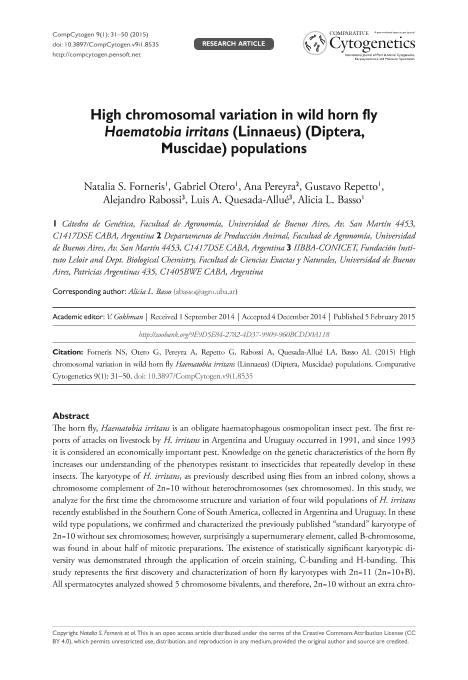Mostrar el registro sencillo del ítem
dc.contributor.author
Forneris, Natalia Soledad

dc.contributor.author
Otero, Gabriel
dc.contributor.author
Pereyra, Ana
dc.contributor.author
Repetto, Gustavo
dc.contributor.author
Rabossi, Alejandro

dc.contributor.author
Quesada Allue, Luis Alberto

dc.contributor.author
Basso, Alicia L.
dc.date.available
2016-12-16T21:14:29Z
dc.date.issued
2015-02
dc.identifier.citation
Forneris, Natalia Soledad; Otero, Gabriel; Pereyra, Ana; Repetto, Gustavo; Rabossi, Alejandro; et al.; High chromosomal variation in wild horn fly Haematobiairritans (Linnaeus) (Diptera, Muscidae) populations; Zoological Inst; Comparative Cytogenetics; 9; 1; 2-2015; 31-50
dc.identifier.issn
1993-0771
dc.identifier.uri
http://hdl.handle.net/11336/9654
dc.description.abstract
The horn fly, Haematobiairritans is an obligate haematophagous cosmopolitan insect pest. The first reports of attacks on livestock by Haematobiairritans in Argentina and Uruguay occurred in 1991, and since 1993 it is considered an economically important pest. Knowledge on the genetic characteristics of the horn fly increases our understanding of the phenotypes resistant to insecticides that repeatedly develop in these insects. The karyotype of Haematobiairritans, as previously described using flies from an inbred colony, shows a chromosome complement of 2n=10 without heterochromosomes (sex chromosomes). In this study, we analyze for the first time the chromosome structure and variation of four wild populations of Haematobiairritans recently established in the Southern Cone of South America, collected in Argentina and Uruguay. In these wild type populations, we confirmed and characterized the previously published "standard" karyotype of 2n=10 without sex chromosomes; however, surprisingly a supernumerary element, called B-chromosome, was found in about half of mitotic preparations. The existence of statistically significant karyotypic diversity was demonstrated through the application of orcein staining, C-banding and H-banding. This study represents the first discovery and characterization of horn fly karyotypes with 2n=11 (2n=10+B). All spermatocytes analyzed showed 5 chromosome bivalents, and therefore, 2n=10 without an extra chromosome. Study of mitotic divisions showed that some chromosomal rearrangements affecting karyotype structure are maintained as polymorphisms, and multiple correspondence analyses demonstrated that genetic variation was not associated with geographic distribution. Because it was never observed during male meiosis, we hypothesize that B-chromosome is preferentially transmitted by females and that it might be related to sex determination.
dc.format
application/pdf
dc.language.iso
eng
dc.publisher
Zoological Inst

dc.rights
info:eu-repo/semantics/openAccess
dc.rights.uri
https://creativecommons.org/licenses/by-nc-sa/2.5/ar/
dc.subject
Karyotypes
dc.subject
Genetic Variability
dc.subject
Population Genetics
dc.subject
C-Banding
dc.subject.classification
Agronomía, reproducción y protección de plantas

dc.subject.classification
Agricultura, Silvicultura y Pesca

dc.subject.classification
CIENCIAS AGRÍCOLAS

dc.title
High chromosomal variation in wild horn fly Haematobiairritans (Linnaeus) (Diptera, Muscidae) populations
dc.type
info:eu-repo/semantics/article
dc.type
info:ar-repo/semantics/artículo
dc.type
info:eu-repo/semantics/publishedVersion
dc.date.updated
2016-12-16T17:54:46Z
dc.journal.volume
9
dc.journal.number
1
dc.journal.pagination
31-50
dc.journal.pais
Rusia

dc.journal.ciudad
Sofia
dc.description.fil
Fil: Forneris, Natalia Soledad. Universidad de Buenos Aires. Facultad de Agronomia; Argentina
dc.description.fil
Fil: Otero, Gabriel. Universidad de Buenos Aires. Facultad de Agronomia; Argentina
dc.description.fil
Fil: Pereyra, Ana. Universidad de Buenos Aires. Facultad de Agronomia; Argentina
dc.description.fil
Fil: Repetto, Gustavo. Universidad de Buenos Aires. Facultad de Agronomia; Argentina
dc.description.fil
Fil: Rabossi, Alejandro. Universidad de Buenos Aires. Facultad de Ciencias Exactas y Naturales. Departamento de Química Biológica; Argentina. Consejo Nacional de Investigaciones Científicas y Técnicas. Oficina de Coordinación Administrativa Parque Centenario. Instituto de Investigaciones Bioquimicas de Buenos Aires; Argentina. Fundación Instituto Leloir; Argentina
dc.description.fil
Fil: Quesada Allue, Luis Alberto. Universidad de Buenos Aires. Facultad de Ciencias Exactas y Naturales. Departamento de Química Biológica; Argentina. Consejo Nacional de Investigaciones Científicas y Técnicas. Oficina de Coordinación Administrativa Parque Centenario. Instituto de Investigaciones Bioquimicas de Buenos Aires; Argentina. Fundación Instituto Leloir; Argentina
dc.description.fil
Fil: Basso, Alicia L.. Universidad de Buenos Aires. Facultad de Agronomia; Argentina
dc.journal.title
Comparative Cytogenetics

dc.relation.alternativeid
info:eu-repo/semantics/altIdentifier/url/http://compcytogen.pensoft.net/articles.php?id=4686
dc.relation.alternativeid
info:eu-repo/semantics/altIdentifier/doi/http://dx.doi.org/10.3897/CompCytogen.v9i1.8535
Archivos asociados
